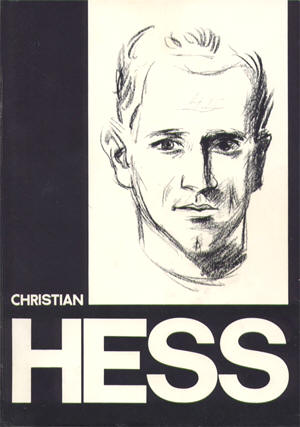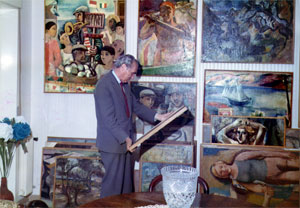|

The 20's for young artists in
Munich were by no means as rosy as was generally
described in accounts of the times. The city,
although owning a rich artistic tradition, was not
particularly open towards avant-garde ideas, to new
forms of expression whether in painting, sculpture
or architecture.
The established, long-standing artistic groups were
not keen to grant exhibition space to new young
talent. Nor could the new wave expect much help from
municipal or state arts bodies. So a small but
enthusiastic band of young artists joined together
in the movement they named Juryfreie with a founding
charter based on mutual friendship and firm
opposition to the entrenched power of the artistic
establishment. Without doubt they saw themselves as
revolutionaries; and they were. At the start of the
1930's anyone interested in meeting these new young
artists and getting to know their work could go to
the exhibition rooms the "Juryfreien" had set up on
the corner of Prinzregenstrasse opposite the Prinz
Carl Palace. Here visitors could see not only
paintings by Juryfreie members but also work by
artists which established galleries (both
state-owned and private) still refused to show.
Abstract and surrealist artists like Albers, Arp,
Baumeister, Brancusi, Max Ernst, Mondrian, Picasso
and Schwitters to name just a few were exhibited for
the first time in Munich thanks to the Juryfreie.
The group also featured work by modern architects
whose designs would otherwise have been ignored. The
movement also organised concerts of contemporary
music featuring the work of composers like Karl
Amadeus Hartmann and Milhaud among others.
Sales of paintings at the exhibitions did not even
cover expenses so the group organised carnival
parties as a way of raising funds. The Juryfreie
parties soon became famous in a city of inveterate
partygoers.
 But the fun soon came to an end with the
arrival of Hitler and his brown-shirted
national socialists. They would decide what
was art and what wasn't. The banning of the
Juryfreie movement was part of a broader
cultural attack aimed at destroying
"Bolshevik" cultural organisations.
Juryfreie members could now only paint,
sculpt and make architectural designs in
hiding. If I have described the situation in
which young artists in Munich found
themselves around 1930 and given an outline
of the Juryfreie's activities, it is because
it was at this time and in this situation
that the painter Christian Hess was living
in the Bavarian capital. I first saw his
paintings at a Juryfreie exhibition. It was
at one of the group's parties that I first
met Hess. He was around 35 with sharp
features and a pleasant, intelligent
expression. He was not very tall, slim and
seemed to possess a typically Bavarian
temperament - but the almost impertinent
openness clearly concealed a deep
sensitivity. I remember at one exhibition on
Prinzregenstrasse I was looking at some
paintings by Joseph Scharl (similar to Van
Gogh) but I was far more struck by the quiet
serene canvasses by Christian Hess which had
been hung alongside. Of all the paintings
which I viewed during that period in Munich
those by Hess are without doubt the ones of
which I maintain the clearest memory. But the fun soon came to an end with the
arrival of Hitler and his brown-shirted
national socialists. They would decide what
was art and what wasn't. The banning of the
Juryfreie movement was part of a broader
cultural attack aimed at destroying
"Bolshevik" cultural organisations.
Juryfreie members could now only paint,
sculpt and make architectural designs in
hiding. If I have described the situation in
which young artists in Munich found
themselves around 1930 and given an outline
of the Juryfreie's activities, it is because
it was at this time and in this situation
that the painter Christian Hess was living
in the Bavarian capital. I first saw his
paintings at a Juryfreie exhibition. It was
at one of the group's parties that I first
met Hess. He was around 35 with sharp
features and a pleasant, intelligent
expression. He was not very tall, slim and
seemed to possess a typically Bavarian
temperament - but the almost impertinent
openness clearly concealed a deep
sensitivity. I remember at one exhibition on
Prinzregenstrasse I was looking at some
paintings by Joseph Scharl (similar to Van
Gogh) but I was far more struck by the quiet
serene canvasses by Christian Hess which had
been hung alongside. Of all the paintings
which I viewed during that period in Munich
those by Hess are without doubt the ones of
which I maintain the clearest memory.
So, when I recently visited Messina and
saw the meticulously curated retrospective of Hess'
paintings, I was able to make my acquaintance once again
with many of his works. There was in no way the sense of
disappointment that sometimes occurs when after decades you
meet an old friend - or an old painting - on the contrary.
Many of the later paintings which I was seeing for the first
time served only to strengthen my previous impressions. The
promise shown by the artist in his early thirties had been
richly fulfilled in his later works. I could not have known
this in 1948 when at a vast exhibition in Munich I saw again
two of Hess' paintings which clearly stood out from the
majority of the works on show for their sheer expressive
power. But by that time, when artists in Germany were once
again able to paint and exhibit their work, Hess was already
dead. He did not have an easy life; perhaps he had not
sought it. Although he did everything well: painting,
drawing, carving puppets, playfully sculpting figures in the
sands on the Baltic coast and modelling with such hard work
and diligence in his studio. He was by no means without
self-criticism and he took his artistic activity far more
seriously than might have seemed to an outsider.
He left the gymnasium early and enrolled in the Innsbruck
State arts and crafts institute where he began painting.
Later he had to work at the Mader
art glass studios in Innsbruck and at the Kuntner ceramic
workshop in Brunico before he was able to begin studying at
the Akademie der Bildenden Künste
in Munich in 1919. Even after he had completed his studies
under Becker Gundhal, Hess had to keep busy in the search to
make some money. In a jeweller in Pforzheim he found not a
patron but a source of commissions for copies of old masters
displayed in museums in Vienna and Florence. Although this
activity hardly served to meet his longing for artistic
affirmation, it is possible to maintain that it did help to
develop and refine his innate sense of colour, shade and
tone. In any case, copying did not lead Hess, as it did
Lenbach, to old-style mannerism. He learned from the old
masters but he reserved the right to find his own way of
expressing form and colour which he found in nature. In the
beginning much of Hess' painting is clearly influenced by
the Munich school. His unflagging enthusiasm for drawing and
painting from nature allowed him to move beyond and find new
freedoms. Above all his long stays in Italy and the summer
he spent in Sicily at his sister's - who had married and
settled in Messina - helped him enormously in the search for
an artistic language in which he could achieve greater
self-expression. In many paintings from 1927 and 1928 there
is a growing sense of colour and an increased precision of
form. The statue of Neptune at Messina, a highly expressive
work by a classicist sculptor, provided the impulse for a
majestic composition in which the real is developed to
almost mythical-allegorical proportions and offers an
element of magical romanticism which in some respects may
remind viewers of De Chirico. Sometimes one may observe a
tendency to overcome form to reach a more expressive
perspective, as in the painting “Ponte di Bracciano” and in
the superbly modelled "Reclining Torso". A group of houses
becomes an abstract composition of red and black cubes.
Emotions found in the paintings of Cezanne are elaborated on
in still lifes of beautiful lyrical reality. In the
landscapes the graduation of colours and tones is majestic.
Towards 1930 the nudes - in drawings and paintings - become
more animated and in the same period there are also still
lifes of clearly abstract construction. For all those who
decades ago saw only a few individual paintings by Christian
Hess this exhibition which brings together his oil paintings
and drawings - unfortunately examples of his plastic art
have almost completely disappeared - offers a first look at
the development of this richly talented artist. All the other artists are present with one work, allowing us
to place Christian Hess clearly among the most interesting
talents to have come out of the rich traditions of the
Munich school in the period between the two wars and follow
new directions.
Hans Eckstein |